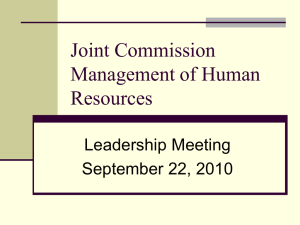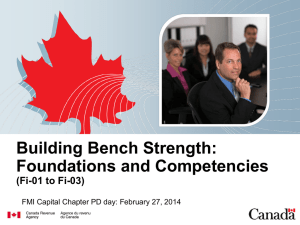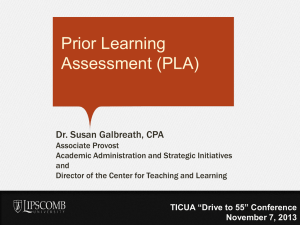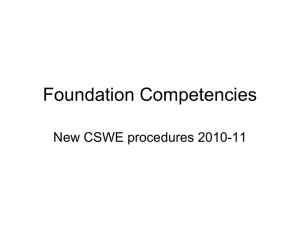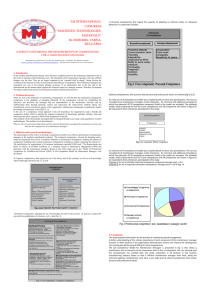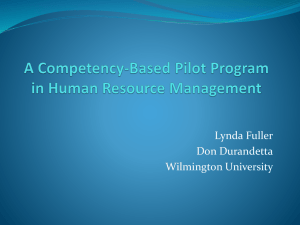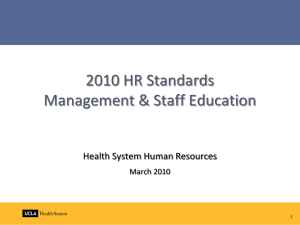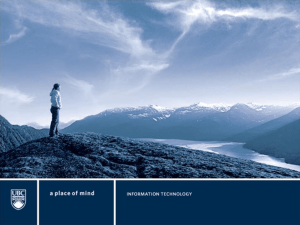Dean Charla Long
advertisement
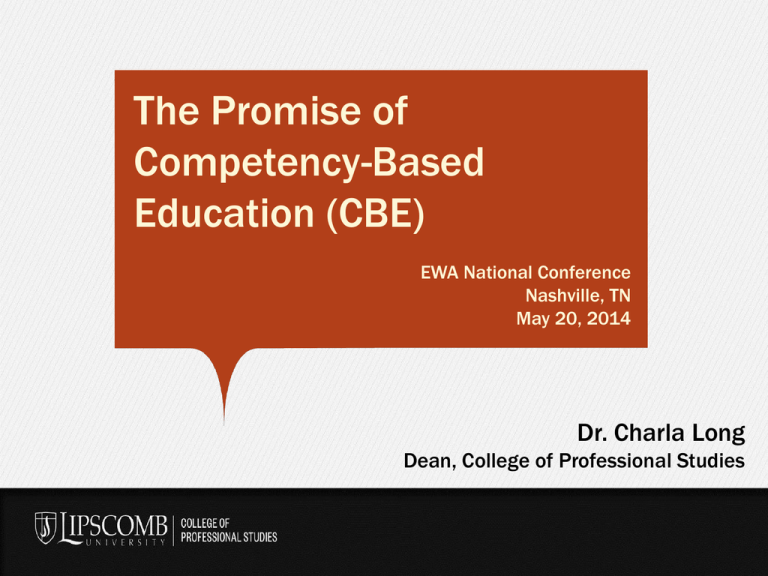
The Promise of Competency-Based Education (CBE) EWA National Conference Nashville, TN May 20, 2014 Dr. Charla Long Dean, College of Professional Studies “Competency-based approaches to education have the potential for assuring the quality and extent of learning, shortening the time to degree/certificate completion, developing stackable credentials that ease student transitions between school and work, and reducing the overall cost of education.” ~Dear Colleague Letter, DOE, March 2013 What are Competencies? Knowledge Skills Ability Attitude Every workplace role is, at the simplest level, a collection of competencies. Every role has a unique competency combination. Every role requires different levels of competence. Focus is on what’s needed to be successful in that role. CBE Definition Academic program INTENTIONALLY DESIGNED to ensure students can DEMONSTRATE their LEARNING of the knowledge, skills, abilities, and attitudes NEEDED by person IN THAT MAJOR field of study by utilizing AUTHENTIC ASSSESSMENTS that are VALIDATED FOR QUALITY. How are Competencies Used in Higher Ed? Every academic major or program has unique competency combination. Some competencies apply to everyone – like general education requirements. Other competencies focus is on the knowledge, skill, ability, and attitude person with that major/degree should possess. CBE shifts thinking from course completion to competence achievement. When a student demonstrates competence, they get “credit” for it. Doesn’t matter how or when the competence is developed. Current Federal Happenings President Obama openly supports CBE. U.S. DOE is exploring “experimental sites” to waive some Title IV (financial aid) requirements for CBE innovation. Major foundations (Gates, Lumina) are funding CBE work. Competency-Based Education Network (CBEN) determining best practices and scaling/spreading models. Congressional Briefings Today’s Adult Learner Lipscomb Story Story Began in 2007 Before the National Movement Had Started Step 1 •Define Competencies Requirement: Connect to the workplace. Requirement: Include tested, proven, reliable and valid performance indicators identified by employers. Requirement: Use a valid competency model. Licensed the Organization Systems International’s Polaris Model A competency model used by over 150 employers, including many Fortune 100 companies Polaris Competency Model 41 Key Competencies Includes expandable competencies like Functional/Technical Expertise, Organization Knowledge, Industry Knowledge, Technology Savvy 7 Categories Communication Conceptual Contextual Interpersonal Leadership Management Personal Competency Examples Communications Active Listening Communicativeness Presentation Skills Leadership Change Mastery Influence Conceptual Problem Solving & Decision Making Management Organizing & Planning Interpersonal Assertiveness Conflict Management Relationship Building Team Player Personal Composure Initiative Mission Focus Results Orientation •Establish Competency Framework Step 2 Not every role needs every competency. Different roles may require differing levels of proficiency. Performance indicators suggest behaviors for each level. Competence can be mapped against an employee pipeline. Pipeline Equivalent Proficiency Level Description of Competency Proficiency Strategic Leader 4 Master/Guru Demonstrates mastery of competency and is capable of mentoring & coaching others in its application. Functional Manager 3 Exceptional/Exp ert Demonstrates expert application of competency and is capable of coaching others in its application. First Level Supervisor 2 Accomplished Practitioner Demonstrates advanced competence and is capable of modeling this competency for others. Individual Contributor 1 Basic/Elementa ry Possesses the fundamental knowledge, skills, and motivations needed for this competency, can consistently apply this competency. 0 Inadequate Falls short of the knowledge, skills, and motivations needed in this competency for role. Development is needed to reach required standard. •Create a Badging Ecosystem Step 3 Electronic Storage and Display Electronic Storage and Display •Choose Rigorous Assessments Step 4 Requirements included: Objective and consistent Relevant and job related Precise and in-depth Valid and highly reliable Fair and provide opportunities to demonstrate skills Supportive of diversity Assessment choices included tests, projects, and behavioral-based measures. Connection to what person can demonstrate led us to choose behavioral or project-based assessments as primary tools. Active Listening Criterion Active Listening Criterion In-Basket Interview Step 5 •Customize as Needed Full deck of 41 competencies Allows for build out based on: Technical expertise Functional knowledge Organizational knowledge Industry knowledge Lipscomb creates custom build outs for corporate clients. Areas to Cover Area 1 •Competencies Defined Area 2 •Competency Framework Area 3 •Badging Ecosystem Area 4 •Rigorous Assessments Area 5 •Customization Area 1 •Competencies Defined Are all competencies clearly articulated? Are you leaving out any “soft skill” competencies and focusing only on technical expertise? Are there commonalities between the different competency standards? Area 2 •Competency Framework Are you direct assessment or credit -based? Do you have “degrees” of competence for a position? Is it a check mark or a level? How do you define the competencies for supervisors, trainers, or assessors of others? Are they at a higher level of the same set of competencies or are additional competencies needed? Do you allow for continuing education or greater competency development? Area 3 •Badging Ecosystem Could you standardize some of the credentials so it could count in multiple arenas? Could badges help individuals build their credentials over time or encourage more diversity? Could badges be positioned as an outward sign of credentials? Area 4 •Rigorous Assessments Only as good as your assessment process Must be able to clearly and consistently evaluate across all credential methods Can’t have double standard for portfolio and classroom What are your requirements? Objective and consistent; Relevant and job related; Precise and in-depth; Valid and highly reliable; Fair and has opportunity to demonstrates skills; Supportive of diversity Area 5 •Customization Do you allow for customization based on market needs? Do you utilize platform to undergird and unite all programs, even when customized? Questions?

